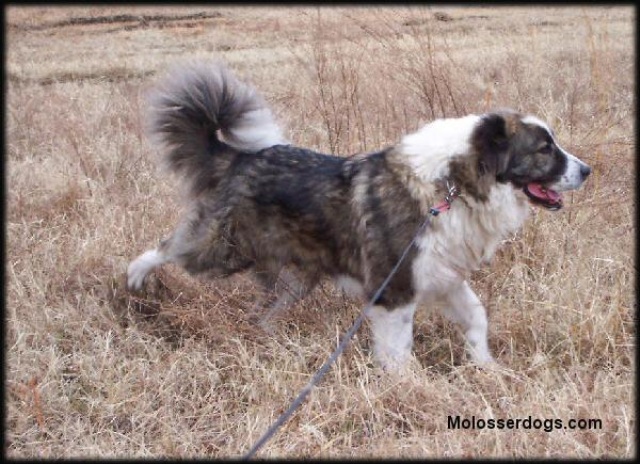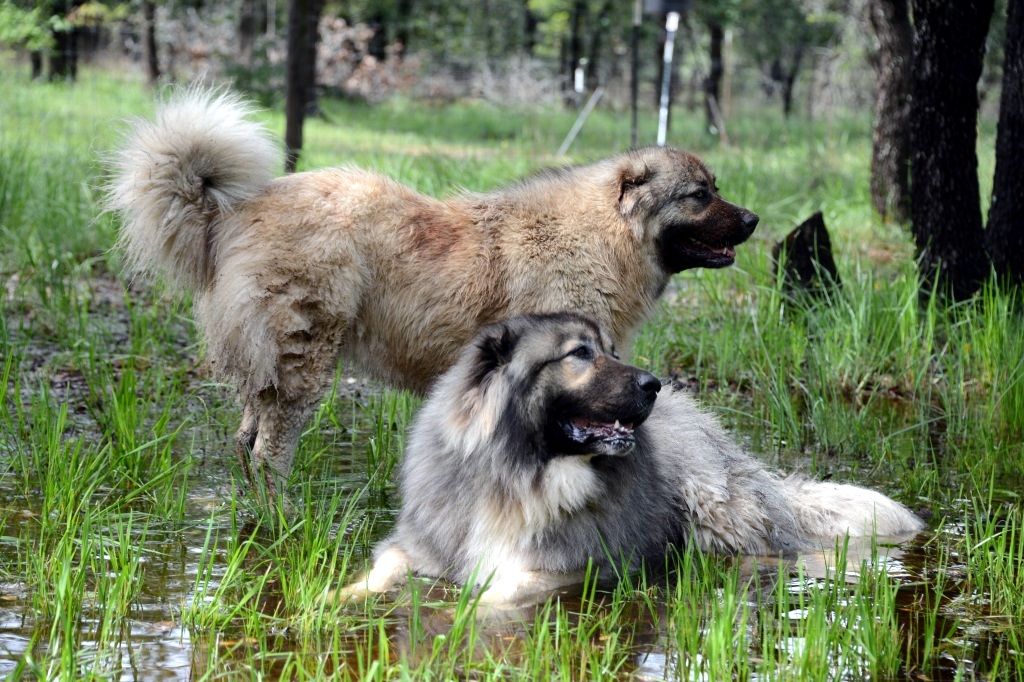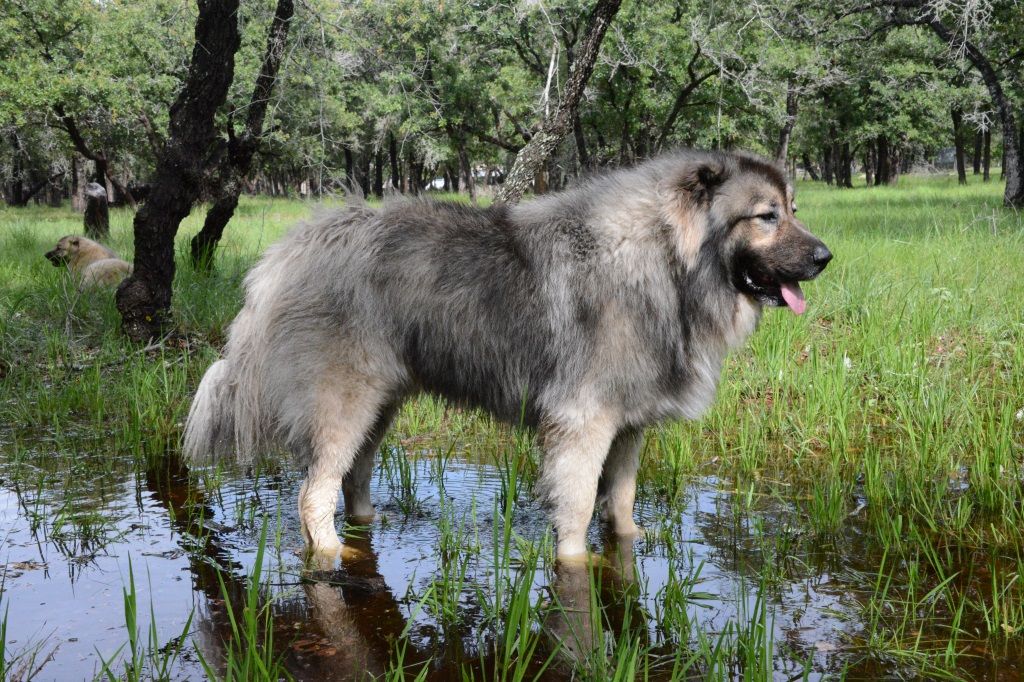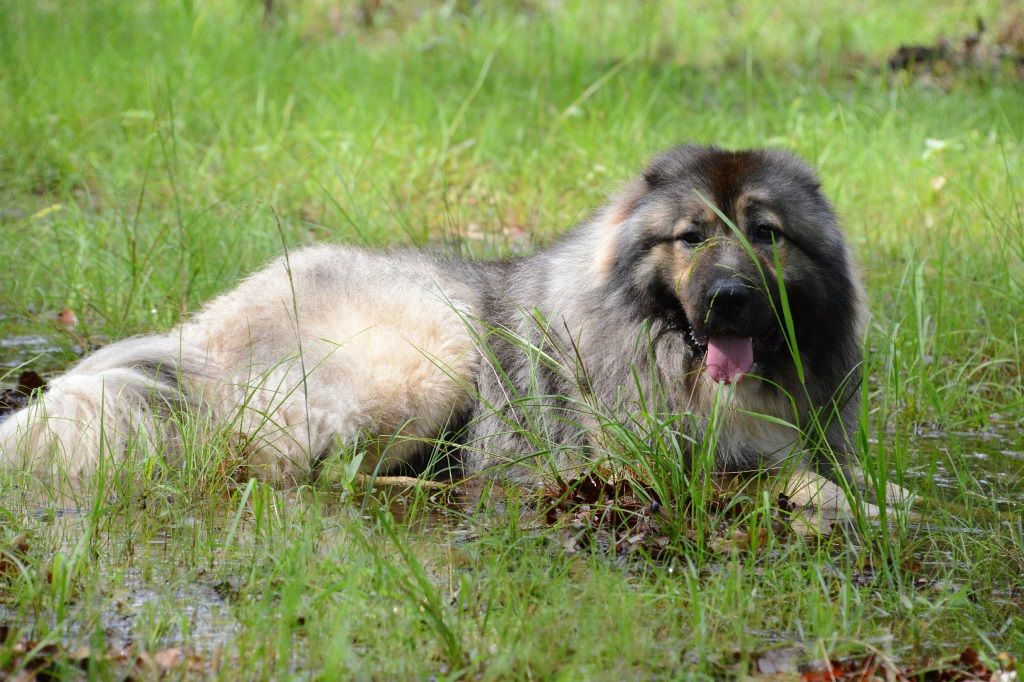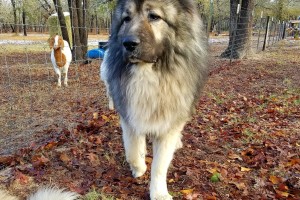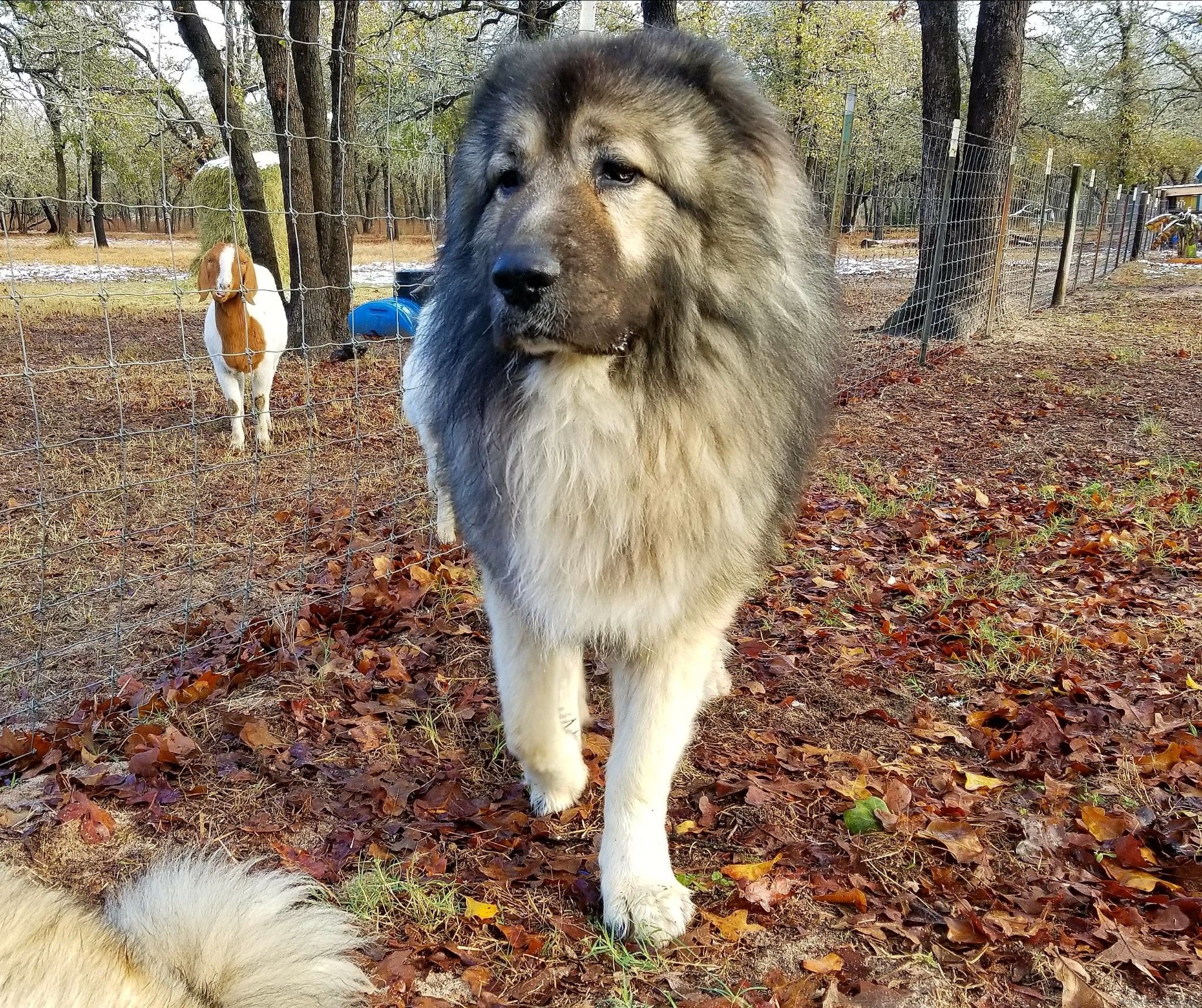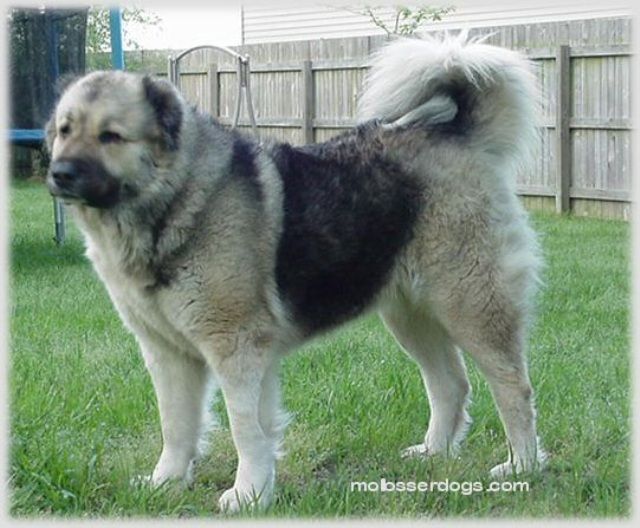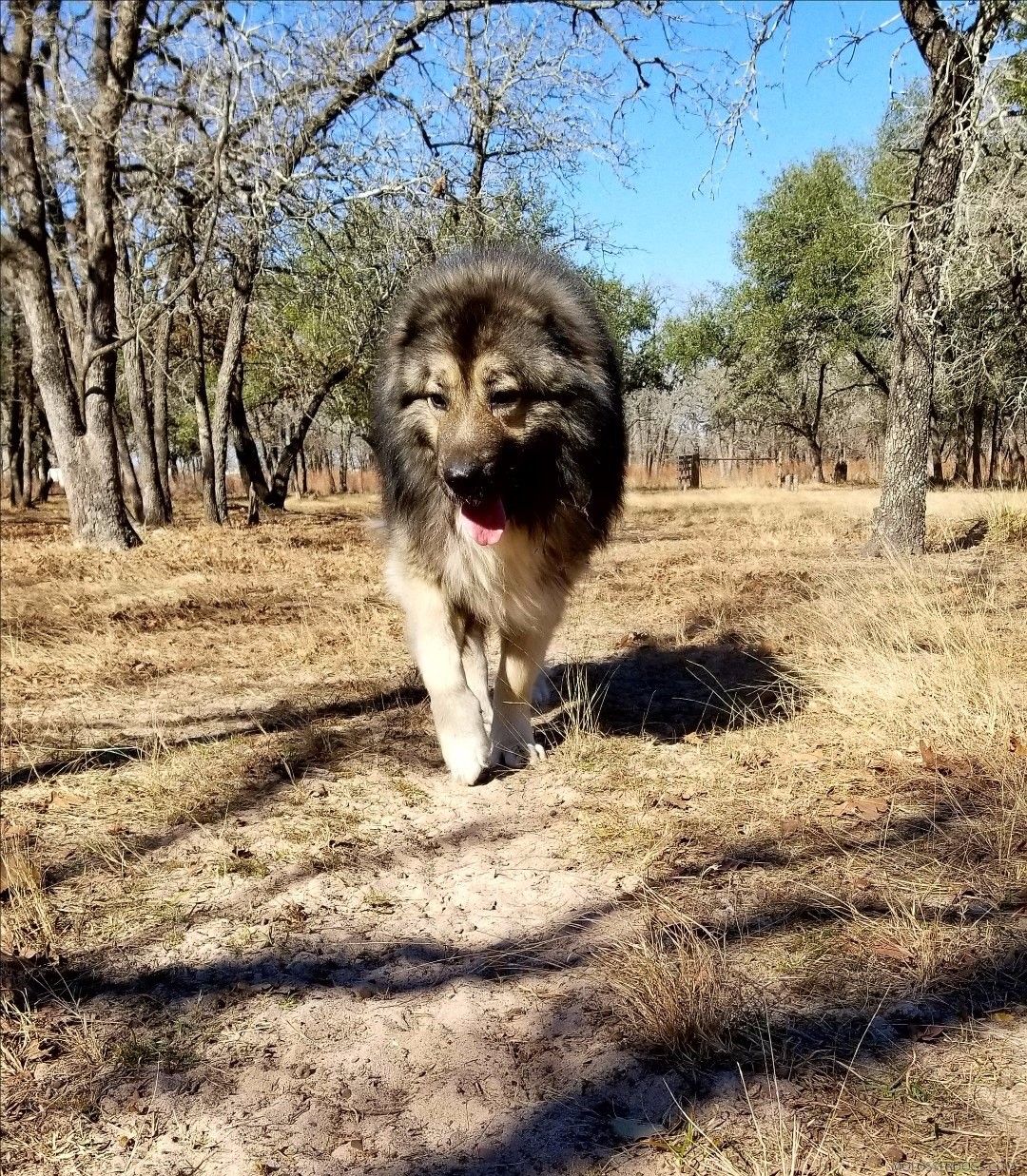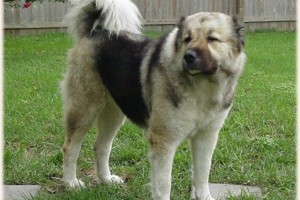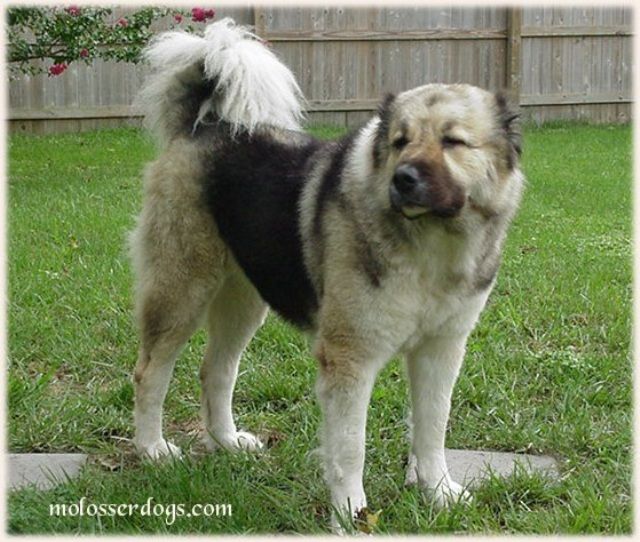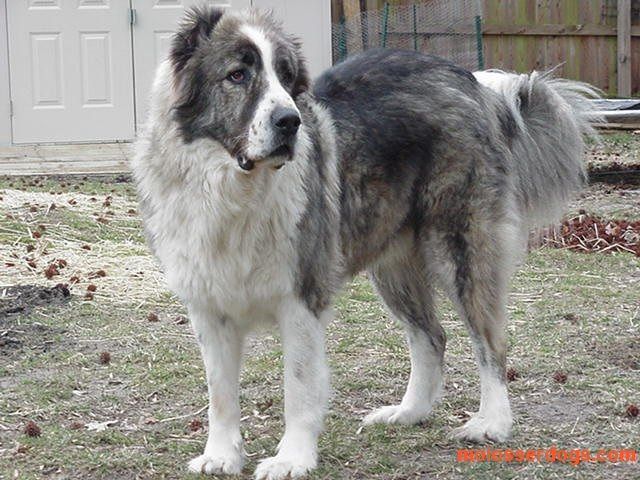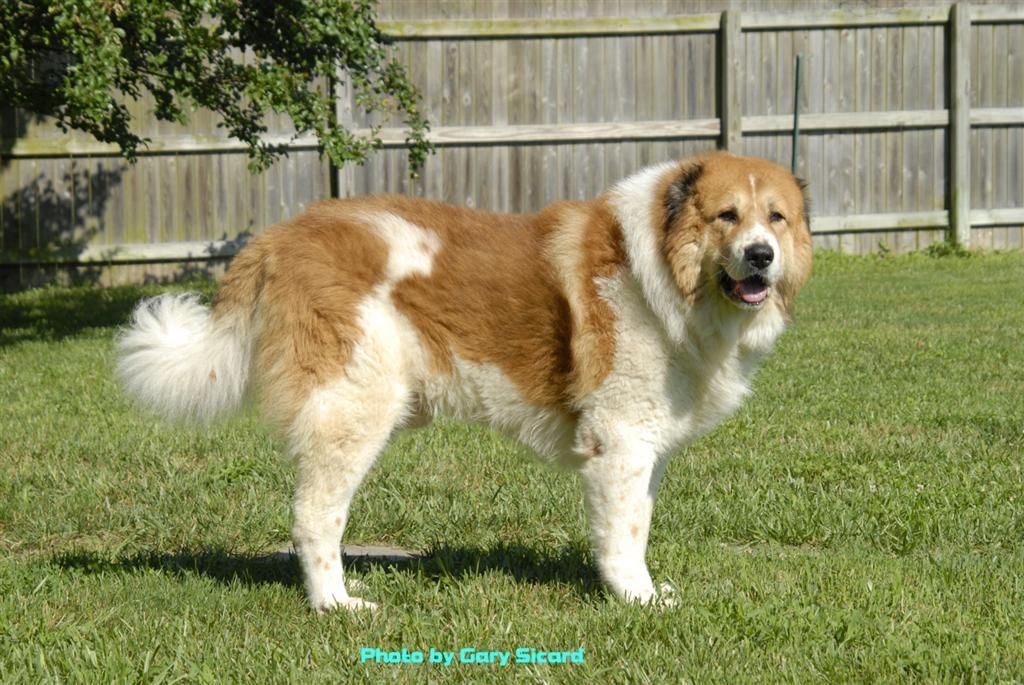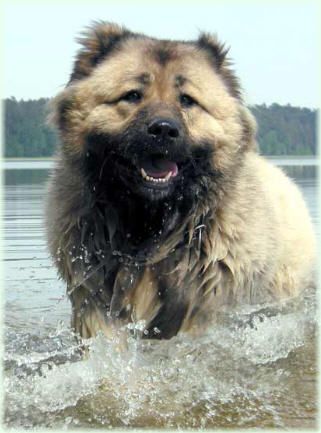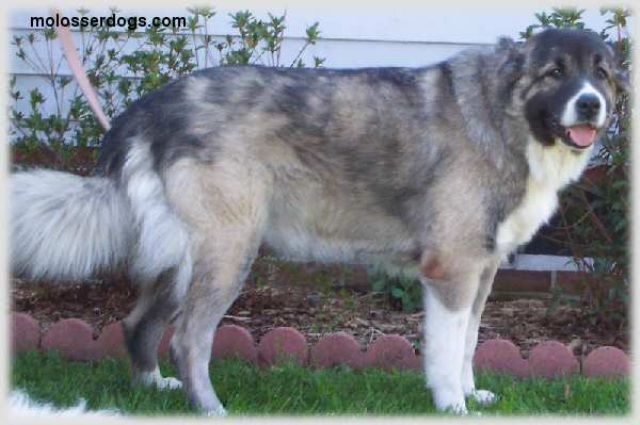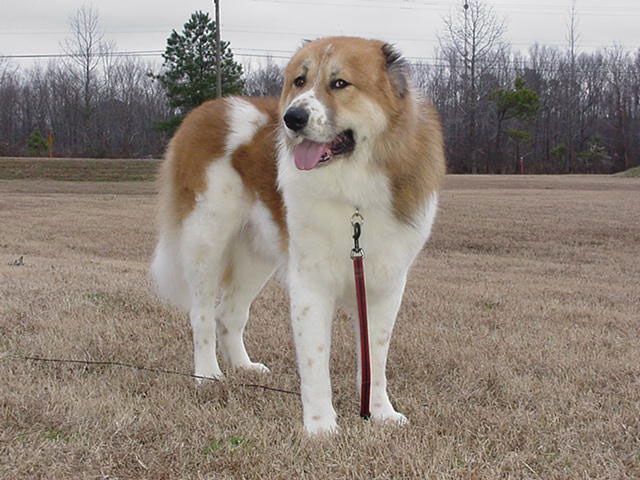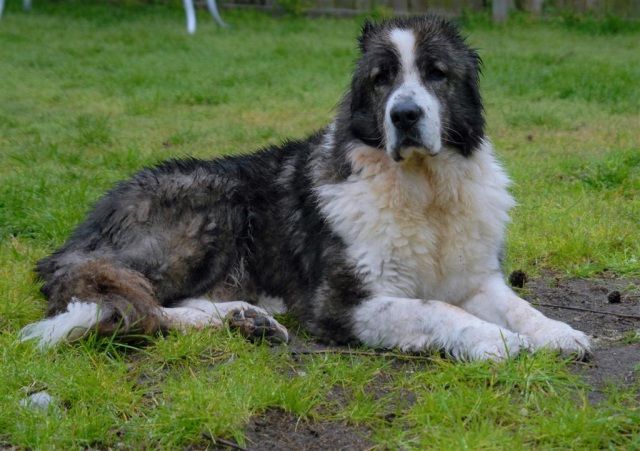Caucasian Shepherd Dog - Kavkazskaya Ovtcharka
Caucasian Shepherd Dog

 Located between the Black Sea on the West and the Caspian Sea on the East, the Kavkaz (Caucasus) mountain range of Eastern Europe represents a true melting pot of various cultures due to a number of nations calling it their home through the ages. Today these influences are still strong and a rich source of cultural wealth of the region, as well as numerous political conflicts. Encompassing the territories of Armenia, Georgia, Azerbaijan, Kabardino-Balkaria, Daghestan, Ossetia, Turkey, Chechnia, Ingushetia and Iran, the Caucasus mountains are also home to one of the oldest living Molossers, the magnificent Caucasian Shepherd Dog. In reality the term "Caucasian Dog" should stand for a group of breeds and not for a single breed or a favored variant.
Located between the Black Sea on the West and the Caspian Sea on the East, the Kavkaz (Caucasus) mountain range of Eastern Europe represents a true melting pot of various cultures due to a number of nations calling it their home through the ages. Today these influences are still strong and a rich source of cultural wealth of the region, as well as numerous political conflicts. Encompassing the territories of Armenia, Georgia, Azerbaijan, Kabardino-Balkaria, Daghestan, Ossetia, Turkey, Chechnia, Ingushetia and Iran, the Caucasus mountains are also home to one of the oldest living Molossers, the magnificent Caucasian Shepherd Dog. In reality the term "Caucasian Dog" should stand for a group of breeds and not for a single breed or a favored variant.
There is a great variety of types among the Caucasian dogs depending on their home region, but due to the ignorance of many Westerners and strong national appetite of Russian and pro-Russian dog fanciers worldwide, a single type bearing a misleading name is being favored in the show rings and literature, at the expense of truth and other breed variants. The exotic-sounding misnomer "Ovcharka" is very popular in the West, thanks to the efforts of the Russian Kennel Club, even though it simply translates to "Sheepdog, Shepherd or Shepherd Dog", making it very unpopular and often insulting among the non-Russian Kavkaz nationals and dog enthusiasts, not only because of the Russian name, but also for the fact that this really isn't a typical sheepdog, since it is neither a herding dog nor a shepherd's companion, but strictly a guardian/protection animal. Considered a Russian breed, the Caucasian Ovtcharka is part of the Troika, a threesome of recognized Russian sheepdogs, the other two being the bearded South-Russian Sheepdog and the somewhat controversial Central Asian Shepherd Dog.

 In order to understand the issues concerning the Caucasian Shepherd Dog, a short historic overview is in order. Although its first official Western Show-Ring appearance was in the 1930's in Germany, the Caucasian Shepherd Dog has existed since ancient times and, like many Eastern Molossers, was introduced to the bloodlines of many of today's World breeds throughout history. Like the Balkans, the Armenian Plateau was one of the earliest cradles of civilization and the first appearance of dogs of this type is closely linked to that area. The Armenian Gamprs are seen as a variant of the Caucasian Shepherd Dog, and while that may be the case, it is also important to note that the Gampr comes in two distinct varieties, both of which are much older than the modern Caucasian and Central-Asian Sheepdogs. A number of researchers see the Caucasian dogs as being the living link between the sheepdogs of the Balkans and mastiffs of Asia, while some believe that the breed was a result of crossing the mountain Gampyrs with spitz-type dogs in ancient times, but these theories, although not without merit, are understandably not very popular.
In order to understand the issues concerning the Caucasian Shepherd Dog, a short historic overview is in order. Although its first official Western Show-Ring appearance was in the 1930's in Germany, the Caucasian Shepherd Dog has existed since ancient times and, like many Eastern Molossers, was introduced to the bloodlines of many of today's World breeds throughout history. Like the Balkans, the Armenian Plateau was one of the earliest cradles of civilization and the first appearance of dogs of this type is closely linked to that area. The Armenian Gamprs are seen as a variant of the Caucasian Shepherd Dog, and while that may be the case, it is also important to note that the Gampr comes in two distinct varieties, both of which are much older than the modern Caucasian and Central-Asian Sheepdogs. A number of researchers see the Caucasian dogs as being the living link between the sheepdogs of the Balkans and mastiffs of Asia, while some believe that the breed was a result of crossing the mountain Gampyrs with spitz-type dogs in ancient times, but these theories, although not without merit, are understandably not very popular.

 Most blame for the confusion surrounding the Caucasian Shepherd Dog should be placed on the Soviet concept, which was famous for erasing facts and re-writing histories of regions under its rule. Even though it was officially non-nationalist, the Soviet regime was obviously pro-Russian, which was manifested through forcing Russian language and cultural ideas on many non-Russian nations it controlled. It should be noted that the Russian introduction to the Kavkaz came in 1859, which goes against the theories claiming the ancient Caucasian Shepherd Dog as an indigenous Russian breed. Even Stalin himself wasn't Russian, but a Georgian native. In this respect, the Turks could lay more claim on the breed, seeing how they ruled the region before the Soviets did and are known to had used Caucasian dogs as guardians for their camps and forts as far back as the 1700's. The same case could be made for pre-Turkish rulers of the area, but this could turn into into a vicious circle of "who came first?", even further complicating the issue. Politics and nationalism should never mix with dog-culture, but unfortunately they do and oftentimes have terrible consequences for the breed.
Most blame for the confusion surrounding the Caucasian Shepherd Dog should be placed on the Soviet concept, which was famous for erasing facts and re-writing histories of regions under its rule. Even though it was officially non-nationalist, the Soviet regime was obviously pro-Russian, which was manifested through forcing Russian language and cultural ideas on many non-Russian nations it controlled. It should be noted that the Russian introduction to the Kavkaz came in 1859, which goes against the theories claiming the ancient Caucasian Shepherd Dog as an indigenous Russian breed. Even Stalin himself wasn't Russian, but a Georgian native. In this respect, the Turks could lay more claim on the breed, seeing how they ruled the region before the Soviets did and are known to had used Caucasian dogs as guardians for their camps and forts as far back as the 1700's. The same case could be made for pre-Turkish rulers of the area, but this could turn into into a vicious circle of "who came first?", even further complicating the issue. Politics and nationalism should never mix with dog-culture, but unfortunately they do and oftentimes have terrible consequences for the breed.

 When Russians started importing Caucasus dogs to Moscow, they separated them into two types, the mountain dogs receiving the name "Trans-Caucasian Ovtcharka" after the Trans-Caucasus region, consisting of Armenia, Georgia and Azerbaijan, while the shorter-haired and lighter-built type steppe dogs were labeled as the "Kavkaskaya Sobaka". Because of the immense variation in sizes and temperaments within the two "official" types, the Soviets started a standardization programme which resulted in an official standard change in the 1970's, when the Russian Kynological Federation made the decision to promote a single type, under the name of "Caucasian Ovtcharka", abandoning their earlier definitions. They agreed that the "best" type is the Georgian bear type, as supposedly favoured by Stalin. The Russian-favored Georgian type is actually a hybrid, created by crossing the Nagazi and Mt.Kazbek variants, both of which still exist in Georgia.
When Russians started importing Caucasus dogs to Moscow, they separated them into two types, the mountain dogs receiving the name "Trans-Caucasian Ovtcharka" after the Trans-Caucasus region, consisting of Armenia, Georgia and Azerbaijan, while the shorter-haired and lighter-built type steppe dogs were labeled as the "Kavkaskaya Sobaka". Because of the immense variation in sizes and temperaments within the two "official" types, the Soviets started a standardization programme which resulted in an official standard change in the 1970's, when the Russian Kynological Federation made the decision to promote a single type, under the name of "Caucasian Ovtcharka", abandoning their earlier definitions. They agreed that the "best" type is the Georgian bear type, as supposedly favoured by Stalin. The Russian-favored Georgian type is actually a hybrid, created by crossing the Nagazi and Mt.Kazbek variants, both of which still exist in Georgia.
The strong influence of some Central Asian bloodlines shouldn't be ignored. Modern incarnation of the Russian show type also has a small percentage of St.Bernard, Sarplaninac, Leonberger, Moscow Watchdog and even Scottish Collie and Tibetan Mastiff blood running through its veins, courtesy of ambitious Soviet breeders trying to create a more agreeable personality, richer coats and a greater variety of colorings in their "Ovtcharka" stock. When the Soviet military was developing the Moscow Watchdog in the post WW2 years, they imported Armenian and Azerbaijan mountain dogs and crossed them with St. Bernards, resulting in an excellent service dog, but also in a demise of certain bloodlines of Caucasian dogs. During the Cold War, the Caucasian Shepherd Dog was a breed commonly seen wherever the Soviet Army was stationed, including many areas of Central Asia and some parts of Europe, such as east Germany, where they were famously used as patrol dogs guarding the Berlin Wall. Many of these working strains have been crossed with indigenous breeds of these regions over the years, affecting both the native dogs and the CO breed. For instance, in Germany there was an increase in size and coat length within some lines of the German Shepherd Dog, effects of which can still be observed in certain types of the modern GSD breed today, but also in some Caucasian Ovcharkas on occasion. After the fall of the Wall, over 7000 of these dogs are believed to had been disbanded and left behind, where they were adopted by many German families and dog enthusiasts, becoming one of the building blocks for the modern Caucasian Ovtcharka, along with the Russian show type. Because military bloodlines come in a variety of colors, sizes and temperaments, they aren't favored among some modern Russian breeders who are pushing for a single type, the aforementioned bear variant of the Georgian dogs, preferred in shades of wolf-gray colours.
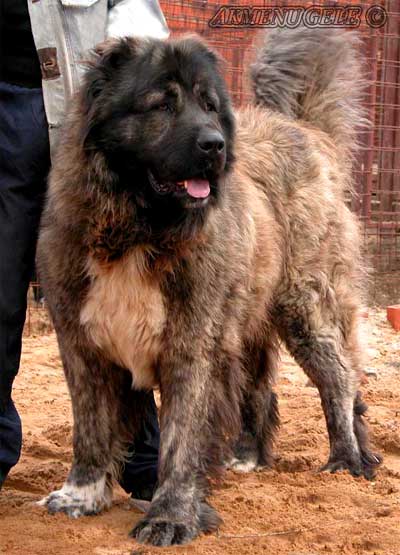
 The main Russian bloodlines can be traced to Moscow, Perm, Ekaterinburg, Tambov, Orenburg, Magnitogorsk, Celjabinsk, Novosibirsk, Donjeck, Lugansk, Ivanovo, Nizhi-Novgograd and St.Petersburg, even though there are many different Caucasian strains still found in the Caucasus mountains. In recent years, the term "Aboriginal" is being used to describe older, non-show mountain bloodlines, but this is very misleading and often used as a trendy marketing ploy by some breeders. Even though most dogs in the Caucasus are working hybrids between various types, there are still some distinguishing characteristics among regional variants. For instance, the Georgian dogs are divided into the large, longhaired and often multicoloured Mkinvartsveri Kazbek type and the slightly smaller wolf-grey Nagazi dogs of medium-length coat with longer muzzles, but there is also a separate breed known as Tushetian Nagazi or Georgian Caucasian Sheepdog in Georgia, which represents the original Gruzian population of the breed, with the pure white dogs being the most valued. Daghestan dogs are tall, wide-headed and athletic, always short-haired and multicoloured. Astrakhan type is found in the Kabardino-Balkarian region and is believed to be a cross between the Russian show type and the old Circassian and Kazbek dogs, but Balkarian Molossers are also rooted in the Sarmatian Mastiff.
The main Russian bloodlines can be traced to Moscow, Perm, Ekaterinburg, Tambov, Orenburg, Magnitogorsk, Celjabinsk, Novosibirsk, Donjeck, Lugansk, Ivanovo, Nizhi-Novgograd and St.Petersburg, even though there are many different Caucasian strains still found in the Caucasus mountains. In recent years, the term "Aboriginal" is being used to describe older, non-show mountain bloodlines, but this is very misleading and often used as a trendy marketing ploy by some breeders. Even though most dogs in the Caucasus are working hybrids between various types, there are still some distinguishing characteristics among regional variants. For instance, the Georgian dogs are divided into the large, longhaired and often multicoloured Mkinvartsveri Kazbek type and the slightly smaller wolf-grey Nagazi dogs of medium-length coat with longer muzzles, but there is also a separate breed known as Tushetian Nagazi or Georgian Caucasian Sheepdog in Georgia, which represents the original Gruzian population of the breed, with the pure white dogs being the most valued. Daghestan dogs are tall, wide-headed and athletic, always short-haired and multicoloured. Astrakhan type is found in the Kabardino-Balkarian region and is believed to be a cross between the Russian show type and the old Circassian and Kazbek dogs, but Balkarian Molossers are also rooted in the Sarmatian Mastiff.
The Turkish Caucasus dogs are divided into 4 types, those being the Garban, the Akhaltsihnske type, the Circassian variant and the Kars Dog. The large, short-muzzled, shorthaired fawn, brown, red, with or without white markings and extremely vicious Garban (Gorban) was developed from the Kars and the Kangal, as well as other Turkish dogs being crossed with the Armenian and Kazbek types. The Akhaltsihnske type was then created from the Garban crosses with the Georgian Nagazi variant and possibly Turkish Akbash, resulting in longhaired, lightly built solid-coloured white, fawn and grey dogs. The Circassian variant is believed to be a result of crossing the Kangals with the Cherkes dogs introduced to Turkey after the Russian-Circassian wars.
The Kars Dog is a variety closely associated with the Kars province of modern Turkey and is today seen as a separate breed. The Armenian Gamprs are usually slightly smaller than the Georgian dogs and are shorter-necked and more squarely built, also allowing for a great variety of colours, even brown or black. The Azerbaijan Volkodav variant also comes in two types, with the longhaired mountain and short-coated steppe dogs both being smaller than Georgian and Armenian types, always having black masks. A result of matings between the dogs of southern Kavkaz with the Sage Mazandarani and the Kars Dog of Turkey, the Iranian Sage Ghafghazi is a lean, powerful and richly coated mastiff, used as a caravan protector of the Shahsavan nomads, who have been breeding it since the 17th century. These Iranian Caucasians come in a variety of colours, both solid and bicoloured. There is also a rare shorthaired Kavkaz mastiff, known as the North-Caucasian Volkodav, which is on its way to receive a separate breed recognition. It should be noted that even the legendary Alaunt, the breed considered to be the key progenitor of all western bulldogge breeds, is also rooted in the East and closely connected to this Caucasian stock of working dogs.

As mentioned above, most working Caucasian dogs are hybrids between established types, as well as some lines of the Central Asian dogs, in effect making the Russian show type appear to be a superiourly-bred dog in the eyes of the West. This is of course due to in part to the main difference between the Eastern and Western ways; the dogs being bred strictly for work in the East and primarily for show and companion life in the West. Apart from the obvious influence of the Central Asian Shepherd, the fighting strains of the Caucasian Ovcharka can also contain a drop or two of blood of some European and American breeds, from certain mastiffs, such as the Mastino Napoletano and English Mastiff to even some smaller working bullies like the Pit Bull Terrier and Bandogge, but these crosses are not as prevalent in the CO as they are in the CAO breed and are rarely seen outside of the fighting circles.
The Caucasian Molossers were used for centuries to protect properties, guard livestock, kill wolves, hunt bears and for many other duties, but today and especially in the West, they're most commonly employed as companion animals and watchdogs. Most prized as an aggressive property guardian, the mighty Caucasian Ovcharka is an intimidating and committed protector with no equal. The Caucasian Shepherd Dog is generally a low activity dog, seemingly lethargic when not working, but extremely agile and convincing when it feels its family is threatened. Although certain strains are more vicious than others, all Caucasians are very territorial and fairly dog-aggressive, needing early and careful broad socialization, as well as firm, but never forceful handling.

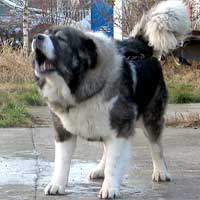 Powerful and massive, the Kavkaz Volkodav can prove to be a serious problem for an inexperienced owner, because it respects and obeys only those dominant and fair members of the family that it deems superiour to itself. Gentle companions and playful clowns when relaxing with their human "pack", these dogs are generally good with children, although they will not see them as their masters. The great Kavkazec develops a strong bond with its owner and is quite trainable, but will rarely be completely submissive and blindly follow orders, for this is truly a thinking dog, which relies primarily on its own instincts, sometimes even disregarding its master's directions in certain situations. Being a true protection dog, famous for having well-developed guardian instincts, strong defense drive and lightning-fast reflexes, the Caucasian may become too aggressive and even dangerous when owned by weak-willed, ignorant and unsuitable owners who fail to properly control their dogs or recognize the breed's true nature.
Powerful and massive, the Kavkaz Volkodav can prove to be a serious problem for an inexperienced owner, because it respects and obeys only those dominant and fair members of the family that it deems superiour to itself. Gentle companions and playful clowns when relaxing with their human "pack", these dogs are generally good with children, although they will not see them as their masters. The great Kavkazec develops a strong bond with its owner and is quite trainable, but will rarely be completely submissive and blindly follow orders, for this is truly a thinking dog, which relies primarily on its own instincts, sometimes even disregarding its master's directions in certain situations. Being a true protection dog, famous for having well-developed guardian instincts, strong defense drive and lightning-fast reflexes, the Caucasian may become too aggressive and even dangerous when owned by weak-willed, ignorant and unsuitable owners who fail to properly control their dogs or recognize the breed's true nature.

 The Caucasian Shepherd Dog also differs from the majority of other LGD breeds when it comes to its primary drives, because it is more than just a typical livestock guardian which is governed by basic defense drive. Alongside only a handful of other Molossers known for being a "step above" when it comes to the seriousness with which the job of defense is regarded by such dogs, the CO also has an elevated prey drive, which is not a common characteristic of most livestock guardian breeds. Unlike many LGD's whose job was mainly centered around being a deterrent primarily and a "last resort" combatant in addition, the Caucasian Ovtcharka was not only kept to protect the flock and property, but was also expected to chase, engage and even kill those predators that refuse to back off immediately. This addition of prey drives and kill drives to its already intense defensive attitude is what sets the breed apart from most of its relatives and makes the CO an outstanding worker, but it also creates some controversy among the breed fanciers, some of which refuse to acknowledge the breed's legendary temperament for what it really is and what it has been for centuries. When faced with the dilemma of breeding these dogs to be true to their heritage or whether to "soften" them up, an alarmingly numerous portion of modern breeders opt for the latter route, mostly due to difficulties concerning the "marketability" of the breed.
The Caucasian Shepherd Dog also differs from the majority of other LGD breeds when it comes to its primary drives, because it is more than just a typical livestock guardian which is governed by basic defense drive. Alongside only a handful of other Molossers known for being a "step above" when it comes to the seriousness with which the job of defense is regarded by such dogs, the CO also has an elevated prey drive, which is not a common characteristic of most livestock guardian breeds. Unlike many LGD's whose job was mainly centered around being a deterrent primarily and a "last resort" combatant in addition, the Caucasian Ovtcharka was not only kept to protect the flock and property, but was also expected to chase, engage and even kill those predators that refuse to back off immediately. This addition of prey drives and kill drives to its already intense defensive attitude is what sets the breed apart from most of its relatives and makes the CO an outstanding worker, but it also creates some controversy among the breed fanciers, some of which refuse to acknowledge the breed's legendary temperament for what it really is and what it has been for centuries. When faced with the dilemma of breeding these dogs to be true to their heritage or whether to "soften" them up, an alarmingly numerous portion of modern breeders opt for the latter route, mostly due to difficulties concerning the "marketability" of the breed.
As the Caucasian Shepherd keeps getting more popular outside of eastern Europe, the breed's true nature is steadily becoming less talked about and at times downright negated, which is not only disrespectful to its heritage, but also potentially dangerous for its constantly growing number of fans, most of whom are enamoured with the size and beauty of the dogs, instead of the actual temperament characteristics of the breed. Although not all modern bloodlines have identical aggression levels, the breed as a whole is known for its outstanding guarding abilities and is by definition immensely protective. It has even been unfairly described as somewhat of a "loose cannon" by its detractors in recent years, although most such dogs are a result of either poor breeding, irresponsible ownership or bad upbringing. Still, with proper care, handling and training, the Kavkazskaya Ovcharka can be a well-behaved and obedient companion to those who understand this majestic Molosser. While this wonderful ancient breed makes an amenable family dog, it certainly isn't the same thing as a Newfoundland, a Bernese or a St.Bernard and potential owners should be aware of the breed's history and temperament before deciding to tackle the task of raising a Caucasian Shepherd Dog.
 A well-bred Caucasian Shepherd Dog should be a healthy, strongly-boned, muscular and even-tempered Moloss, but some of today's bloodlines are prone to hip-dysplasia, obesity and too soft, as well as overly-vicious temperaments. The body is powerful and strong, with a broad, straight back, a wide, deep chest and a short, muscular neck. Depending on whether the dog belongs to the Mountain or Steppe type, the length of the strong sturdy legs can vary, with the Steppe variety of the breed having longer legs, as well as being overall leaner and oftentimes taller than its Mountain type counterpart, whose legs tend to be slightly shorter and thicker. The heavy Mountain type, while less athletic and rarely found performing the breed's traditional livestock guarding duties in the Caucasus, is today seen as more impressive and thus much more popular than the Steppe variety, especially in Russia and the West, where it is often presented as the "correct" Caucasian Ovcharka, while the true rustic leaner representatives of the breed are usually overlooked in literature and rarely encountered in Dog Shows.
A well-bred Caucasian Shepherd Dog should be a healthy, strongly-boned, muscular and even-tempered Moloss, but some of today's bloodlines are prone to hip-dysplasia, obesity and too soft, as well as overly-vicious temperaments. The body is powerful and strong, with a broad, straight back, a wide, deep chest and a short, muscular neck. Depending on whether the dog belongs to the Mountain or Steppe type, the length of the strong sturdy legs can vary, with the Steppe variety of the breed having longer legs, as well as being overall leaner and oftentimes taller than its Mountain type counterpart, whose legs tend to be slightly shorter and thicker. The heavy Mountain type, while less athletic and rarely found performing the breed's traditional livestock guarding duties in the Caucasus, is today seen as more impressive and thus much more popular than the Steppe variety, especially in Russia and the West, where it is often presented as the "correct" Caucasian Ovcharka, while the true rustic leaner representatives of the breed are usually overlooked in literature and rarely encountered in Dog Shows.
Although the popular "bear" type is known for having massive, at times enormous heads, the CO of any variety must have a large head, with a broad skull, flat forehead, fairly soft stop, a slightly tapered strong muzzle, which is somewhat shorter than the length of the skull. However, females shouldn't resemble male dogs, having lighter heads with strong feminine features. The nose must be strongly pigmented, preferably black, although a dark brown nose is permitted for white-coated dogs. The lips are quite heavy, but shouldn't ever be overly loose. The deep set eyes are moderately small, dark and oval in shape. The ears of the Kavkaskaya Ovtcharka are set high on the head and have traditionally been cropped, although a large number of modern dogs can be seen unaltered. The tail is high set, usually curled over the dog's back. It should be noted that in some regions, working Caucasians can have their tails cut off, which leads neophytes to the breed to mistake them for Central Asian Ovcharkas, even though a docked tail is allowed by the breed Standard and accepted for Shows.

 True working Caucasian Shepherd Dogs will generally have shorter coats, but even though many coat-types and beautiful colours exist, such as golden-yellow, fawn, brindle, reddish-brown, creamy white, pearl white and various piebald shades, the preferred Show-types are the long-coated grey dogs with or without some white markings present. No black or black-n-tan dogs are accepted for Show, but they do exist and are just as ancient as the other traditional colourings. However, tan dogs with a black "saddle" are undesired, since they are thought to show the influence of the German Shepherd, while such markings on gray-coated dogs are naturally common and completely acceptable.
True working Caucasian Shepherd Dogs will generally have shorter coats, but even though many coat-types and beautiful colours exist, such as golden-yellow, fawn, brindle, reddish-brown, creamy white, pearl white and various piebald shades, the preferred Show-types are the long-coated grey dogs with or without some white markings present. No black or black-n-tan dogs are accepted for Show, but they do exist and are just as ancient as the other traditional colourings. However, tan dogs with a black "saddle" are undesired, since they are thought to show the influence of the German Shepherd, while such markings on gray-coated dogs are naturally common and completely acceptable.
Occasionally, blue-coloured Caucasians can be encountered, but aren't accepted for Shows, with some fanciers suspecting the Tibetan Mastiff and even Neapolitan Mastiff influence in such examples, although this unusual colouring can also occur naturally at times in purebred breed representatives.
The height ranges anywhere from 23 to 34 inches among working specimens, but most modern dogs are around 28 inches tall.
-
This is one of my favorite breeds. I saw a few at a dog show once. I think it was an IABC show. Wonderful. The dogs were regal. But some dog did something that one of the dogs didn't like. Then all of the Caucasian responded with bad intentions for that dog. The owners calmly maintained their composure. The dogs quickly calmed down. I was very impressed. I wanted to know more about the breed. Initially I thought the owner was going to have a hard time. These dogs were going to be impossible to restrain. But they weren't. They didn't drag anyone. They responded to the calm nature of their owners or handlers. They appeared as though they were never bothered.






